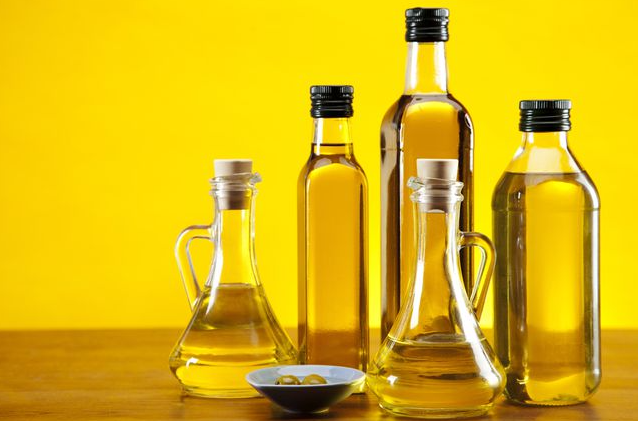How to Choose the Cooking Oil Properly [Complete Guide]

Cooking oils are pure fat; however, they are not produced equally. Every cooking oil is a combination of polyunsaturated, saturated, and monounsaturated fats. It is the hydrogen concentration that defines how they are categorized. Without being too technical, the following information will provide basic facts about fats.
Saturated Fats:
Saturated fats are extracted from animal products and are converted into cholesterol through the liver. Margarine, meats, butter, and dairy products are especially high in saturated fat. Saturated fats elevate blood cholesterol levels and are associated with increased rates of stroke and heart disease. It remains solid at room temperature.
Unsaturated Fats:
There are two kinds of unsaturated fats: polyunsaturated and monounsaturated.
Polyunsaturated and monounsaturated fats do not elevate blood cholesterol levels. Olive and canola oils carry the highest proportion of monounsaturated fat compared to other cooking oils. Corn and safflower oil is the highest in polyunsaturated fats.
Trans Fats:
Trans fats are processed or man-made fats that are made from liquid oil. When processors add hydrogen to liquid vegetable oil with pressure, the result comes out as stiffer fat, similar to the fat found in a can of Crisco.
Trans fats are also known as hydrogenated fats that are found in margarine and partially hydrogenated vegetable oils. These fats create a greater risk of heart disease compared to saturated fats (once known to be the worst kind of fats).
It is a fact that saturated fats (found in cheese, beef, butter, coconut, and palm oil) elevate total cholesterol levels; however, trans fats raise total cholesterol levels and they also deplete good cholesterol (HDL), which offers protection against heart disease.
Partially Hydrogenated Fats:
If you carry health concerns with you, read food labels and know if they have added “partially hydrogenated oil” as an ingredient. Partially hydrogenated oil is present in every commercially produced food including:
- crackers,
- cookies,
- pastries,
- donuts,
- deep-fried foods (including those from all major fast-food chains),
- potato and corn chips,
- imitation cheeses,
- confectionery fats
All these products contain unsaturated fats that can be damaged at high temperatures and can be converted into trans fat.
Difference between Unrefined and Refined Cooking Oils
Unrefined Oils:
Unrefined oils are processed oil by expeller-pressed and cold-pressed methods. They have the true flavor of plants from which the oil is created. The strong unrefined oils’ flavor may overwhelm the baked good or dish that is prepared through them. However, strong flavor is always not undesirable while some unrefined oils are used as flavoring agents.
Typically, these oils are called salad oils and used for marinades, sauces, salad dressings, and as light cooking oils for low heat baking and light sauteing.
As a general rule, unrefined oils should not be cooked at high temperatures. (Only exception is unrefined safflower oil, capable of reaching a temperature essential for deep-frying.) Unrefined oils should not be used at 320°F or above.
Refined Oils:
Refined oil is extracted by solvent extraction for further refining to produce clear oil, which is free from foreign matter and rancidity. These oils are added as
- medium cooking oils (225°F to 350°F),
- high cooking oils (350°F to 450°F), and
- deep-frying oils (greater than 450°F)
Refined oils are pale and bland. They have negligible aroma and flavor that makes them perfect for preparing delicately flavored dishes. They are used for:
- sauteing,
- browning,
- stir-fry and wok cooking,
- baking,
- searing,
- pan-frying, and
- deep-frying
Various Cooking Oils with Recommended Usage
Some oils contain low smoke points. It suggests they will burn at low temperatures. These oils, generally called salad oils, are best suited for marinades, salad dressings, sauces and as light cooking oils for light sautes and low heat baking. Other cooking oils have a high smoke point, which means that they can reach higher temperatures without smoking. These particular oils are ideal for deep-frying, pan-frying, and sauteing. The information below will discuss various types of cooking oils and their recommended use.
Sunflower –
Produced by the sunflower oil supplier from sunflower seeds, sunflower oil has a pale yellow color. It has a bland flavor and is seen as good, all-purpose oil. Sunflower has low saturated fat and is high in polyunsaturated fat.
Semi-refined sunflower oil has a smoke point of 450°F, which is excellent for preparing salad dressings, sauteing, deep-frying and pan-frying.
Canola –
Canola oil is a monounsaturated oil drawn out from a plant’s seeds from the mustard family. It contains a mild aroma and flavor, most commonly available in a refined form. Canola has a bland flavor while it is recommended for pan-frying, deep-frying, sauteing, baking, and preparing salad dressings.
Its relatively high smoke point and mild flavor make refined canola oil an all-purpose oil. Among all the cooking oils, canola carries the least amount of saturated fat (6%). It is also among the least expensive cooking oils.
Corn –
Made from the corn kernel’s germ, corn oil is tasteless and is high in polyunsaturated fat (62%). Corn is used to making salad dressings, margarine, and mayonnaise. With a smoke temperature of 450°F, it is fine for deep-frying and pan-frying as it can sustain high temperatures without smoking.
Olive –
Olive oil is a monounsaturated oil and is extracted from tree-ripened olives. The color might range from green to light amber with flavors ranging from bland to extremely strong. Olive oil gets graded as per its degree of acidity along with the process used for extracting the oil. Olive oil labeled “virgin” is cold-pressed (the process using no chemicals or heat) and contains low acidity levels.
Olive provides the human body with the important vitamins E and F. Oil labeled “pure” uses chemicals and heat to process olive residue from further pressings. Unrefined olive oil contains a smoke point of 320°F, which is recommended for sauteing, baking, stir-frying, and wok cooking.
Peanut –
Made from steam-cooked, pressed peanuts, peanut oil has 18% saturated fat. It contains a blended flavor which is good for cooking because it doesn’t transfer or absorb flavors. Frying with peanut oil offers foods a nutty, rich, roasted flavor. Refined peanut oil contains a smoke point of 450°F; recommended for wok cooking, stir-frying, pan-frying, and deep-frying.
Soybean –
Highly refined soybean oil is versatile, very mild, and it represents around 80% of all the cooking oils used in the USA’s commercial food production. Almost every product that shows vegetable oil as an ingredient most likely has refined soybean oil. Having a smoke point of 450°F, soybean oil is an all-purpose oil. It is used for pan-frying, deep-frying, wok cooking, baking, and stir-frying.




